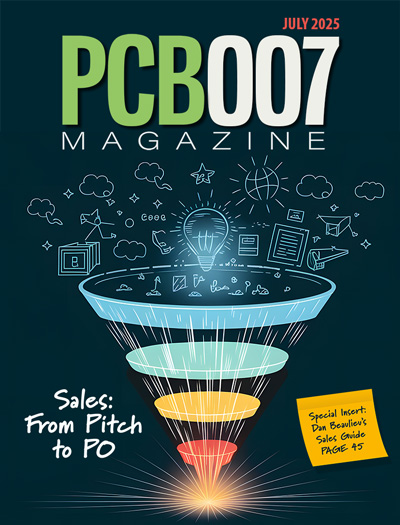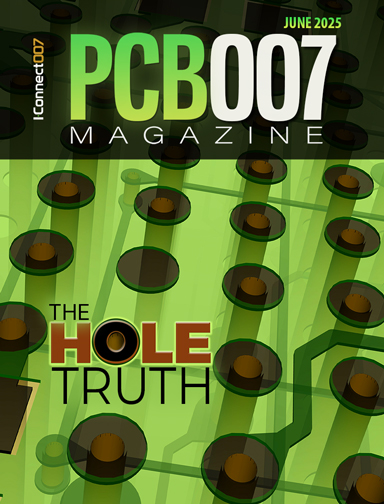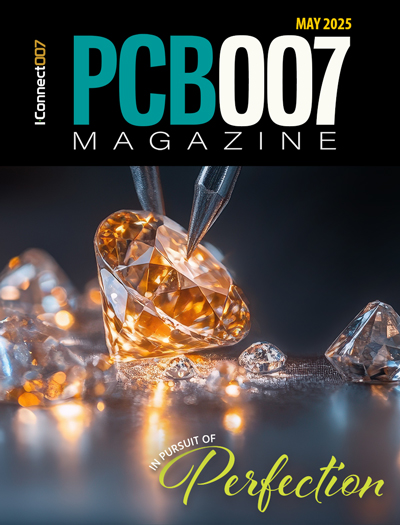-

- News
- Books
Featured Books
- pcb007 Magazine
Latest Issues
Current Issue
Sales: From Pitch to PO
From the first cold call to finally receiving that first purchase order, the July PCB007 Magazine breaks down some critical parts of the sales stack. To up your sales game, read on!

The Hole Truth: Via Integrity in an HDI World
From the drilled hole to registration across multiple sequential lamination cycles, to the quality of your copper plating, via reliability in an HDI world is becoming an ever-greater challenge. This month we look at “The Hole Truth,” from creating the “perfect” via to how you can assure via quality and reliability, the first time, every time.

In Pursuit of Perfection: Defect Reduction
For bare PCB board fabrication, defect reduction is a critical aspect of a company's bottom line profitability. In this issue, we examine how imaging, etching, and plating processes can provide information and insight into reducing defects and increasing yields.
- Articles
- Columns
- Links
- Media kit
||| MENU - pcb007 Magazine
IEEE Researchers Provide Mathematical Solutions to Study 2D Light Interaction in Photonic Crystal Lasers
February 7, 2025 | PRNewswireEstimated reading time: 1 minute
Laser diodes are semiconductors that generate light and amplify it using repeated reflection or 'optical feedback'. Once the light has achieved desirable optical gain, laser diodes release it as powerful laser beams. Photonic crystal surface-emitting lasers (PCSELs) are advanced laser diodes where the optical gain is typically distributed laterally to the propagating light within a photonic crystal (PC) structure. They differ from traditional lasers by separating gain, feedback, and emission functions, offering scalable single-mode power and innovative designs.
In a paper that was recently published in Volume 31, Issue 2 of the IEEE Journal of Selected Topics in Quantum Electronics on 20 November, 2024, researchers have developed a method to numerically simulate the interaction of light waves within PCSELs. The researchers examined how light waves interact within a triangular-lattice PCSEL, where the PC forms a triangular grid structure. They found that the two-dimensional light wave interaction or 'coupling' within triangular-lattice PCSEL was stronger than that in square lattice PCSEL. This increased coupling offers greater optical feedback, which is beneficial for efficient lasing.
The researchers focused on six plane light waves propagating through the crystal and coupling through a process called Bragg diffraction. They then performed numerical simulations of 2D coupling of these plane wave in triangular-lattice PCSEL. Finally, they compared the 2D coupling with those seen in square lattice PCSEL.
The team derived analytical equations for both mode frequencies and coupling constants, which can be used alongside experimental band structure measurements to aid the design of transverse magnetic (TM) triangular lattice PCSELs. 'These equations improve in-plane 2D coupling for TM-mode triangular-lattice PCSELs, which is particularly beneficial for low-index contrast devices', notes Professor Stephen John Sweeney, a senior IEEE member and co-author of the study.
The researchers also derived the general form of the coupled wave equations for unit cells in the crystal lattice, which can further aid the experimental design of PCSELs with superior efficiency. Additionally, the team identified the 'fundamental lasing mode' of triangular-lattice PCSEL, which is the pattern of the electromagnetic field that offers the most efficient laser output.
The findings establish parallels between TM and transverse electric (TE) polarisation behaviours, while emphasizing the unique advantages TM modes offer in certain configurations, particularly in low index contrast devices.
The derived analytical models and coupling equations provide a foundation for experimental optimization of photonic crystal structures, enabling targeted enhancements in device efficiency and performance.
Testimonial
"Our marketing partnership with I-Connect007 is already delivering. Just a day after our press release went live, we received a direct inquiry about our updated products!"
Rachael Temple - AlltematedSuggested Items
Lattice, Mitsubishi Electric Collaborate to Deliver Next-Gen Industrial Automation Experiences
07/23/2025 | BUSINESS WIRELattice Semiconductor, the low power programmable leader, announced its low power Lattice CertusPro™-NX FPGAs now enable Mitsubishi Electric’s Computerized Numerical Controller (CNC) solutions to bring power efficient and reliable factory automation experiences.
Everspin Technology, Lattice Semiconductor Collaborate
02/20/2025 | BUSINESS WIREEverspin Technologies, Inc., the world’s leading developer and manufacturer of Magnetoresistive Random Access Memory (MRAM) persistent memory solutions, today announced that its PERSYST MRAM is now validated for configuration across all Lattice Semiconductor Field Programmable Gate Arrays (FPGA).
Mouser Electronics Honored with 2024 Distribution Excellence Award by Lattice Semiconductor
02/14/2025 | BUSINESS WIREMouser Electronics, Inc., the authorized global distributor with the newest electronic components and industrial automation products, announces it has received the 2024 Distribution Demand Creation Excellence Award for the Americas from Lattice Semiconductor, a leading manufacturer of low-power field programmable gate arrays (FPGAs).
Lockheed Martin and Anduril Join Forces to Successfully Detect and Track Drone Threats in Middle East
11/14/2024 | Lockheed MartinLockheed Martin has successfully integrated the Q-53 multi-mission radar (MMR) with Anduril's Lattice Command and Control (C2) environment during the U.S. Central Command Desert Guardian exercise held at Fort Drum earlier this month. Desert Guardian is part of a set of exercises aimed at filling key gaps in its ability to detect and track drone threats.
Lattice Receives 2024 Top Workplaces USA Award
03/21/2024 | BUSINESS WIRELattice Semiconductor, the low power programmable leader, announced it has been recognized as a 2024 Top Workplace USA. Lattice won the award based on direct employee survey feedback including 15 culture drivers that are proven to predict high performance against industry benchmarks.


